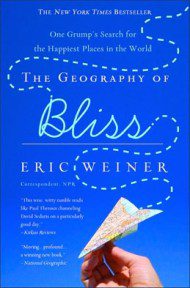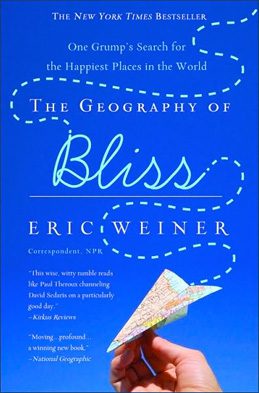 The French call it la chasse au bonheur. Americans have it inscribed into their constitution. The hunt for happiness seems to be a global, fundamentally human pursuit — but what exactly is its actual prey and does that prey have a natural habitat? That’s exactly what Eric Weiner explores in The Geography of Bliss: One Grump’s Search for the Happiest Places in the World — a fascinating tale of psychology, geopolitics, science, travel and humor, and a fine addition to these 7 essential books on happiness. From the relationship between democracy and happiness to the role of religion, temperature and failure in happiness, the book offers a provocative perspective on what happiness is — and isn’t — and where we might find it.
The French call it la chasse au bonheur. Americans have it inscribed into their constitution. The hunt for happiness seems to be a global, fundamentally human pursuit — but what exactly is its actual prey and does that prey have a natural habitat? That’s exactly what Eric Weiner explores in The Geography of Bliss: One Grump’s Search for the Happiest Places in the World — a fascinating tale of psychology, geopolitics, science, travel and humor, and a fine addition to these 7 essential books on happiness. From the relationship between democracy and happiness to the role of religion, temperature and failure in happiness, the book offers a provocative perspective on what happiness is — and isn’t — and where we might find it.
Weiner came of age as an NPR correspondent, reporting from some of the gloomiest, unhappiest places on Earth. So he decided to seek out their opposite and spent a year traveling the globe, hunting down the world’s unheralded happy places, where one or more of the ingredients we consider essential to well-being — pleasure, money, spirituality, family, chocolate — flow unabated. The itch for his quest came from a what-if we’re all familiar with:
What if you lived in a country that was fabulously wealthy and no one paid taxes? What if you lived in a country where failure is an option? What if you lived in a country so democratic that you voted seven times a year? What if you lived in a country where excessive thinking is discouraged? Would you be happy then?”

Our tendency to conflate geography and happiness seems to be more deeply embedded in our thinking and even our language than we realize. We speak about “looking for” happiness and “finding” joy as though these were specific locations on an actual map. Until the 18th century, people even believed the Garden of Eden, the biblical notion of paradise, was a real place, so they depicted in on maps — located, as Weiner notes the irony, at the intersection of the Tigris and Euphrates rivers where modern-day Iraq lies. At the same time, the entire self-help industry is built — and billed — on the premise that happiness is inside us and we simply need to dig it out. But, Weiner argues, both of these notions are wrong — the line between “out there” and “in here” is much finer than we’ve been led to believe and, as he puts it, where we are is vital to who we are.

The journey wavers across ten countries — The Netherlands, Switzerland, Bhutan, Qatar, Iceland, Moldova, Thailand, Great Britain, India and the United States — to uncover the greatest enablers of, as well as obstacles to, happiness, examining in the process a wide spectrum of definitions of what happiness actually is, from Aristotle (“a virtuous activity of the soul”) to Weiner’s personal favorite, by an unhappy man named Noah Webster who penned the first American dictionary (“the agreeable sensations which spring from the enjoyment of good”).
Happy feelings register in the regions of the brain that have evolved most recently. It raises an intriguing question: Are we, in evolutionary if not personal terms, slouching towards happiness?”
In Bhutan, Weiner contemplates their Gross National Happiness as an alternative to GDP as a measure of a nation’s well-being. In The Netherlands, he tracks down Ruut Veenhoven, the godfather of happiness research and proprietor of the World Database of Happiness.
Throughout the narrative, intriguing factoids add delight to journey (did you know that in 1962, the citizens of the Dominican Republic reported the lowest level of happiness recorded in history, a mere 1.6 on a scale of 1 to 10, or that the ubiquitous yellow smiley face graphic was invented by graphic designer Harvey Ball in 1963?), and some perplexing paradoxes begin to emerge — the world’s happiest countries also have high suicide rates; people who attend religious services report being happier than those who don’t, but the world’s happiest nations are secular; countries with a wide gap between rich and poor are no less happy than countries with even wealth distribution.

Weiner’s subtle humor and charming self-derision bring a wink and an exhale to the cerebral, the empirical and the philosophical concepts at the heart of his findings.
Every religion instructs followers in the ways of happiness, be it in this life or the next, be it through submission, meditation, devotion, or, if you happen to belong to the Jewish or Catholic faith, guilt.”
In the end, Weiner comes full circle to the famous words of Henry Miller, with which the book opens:
One’s destination is never a place, but a new way of seeing things.”
The Geography of Bliss is neither a self-help manual nor a pop-psychology book. Instead, its ultimate quest for the objective elements of happiness is, ironically yet intriguingly, just one man’s subjective interpretation of the conditions and complexities of well-being. And, like happiness itself, the book’s beauty lies in the layered insights of its subjectivity.



